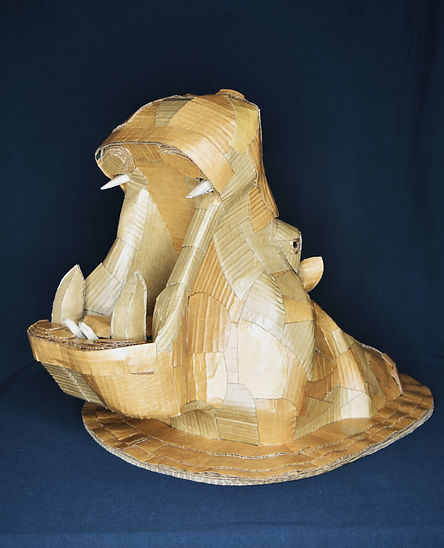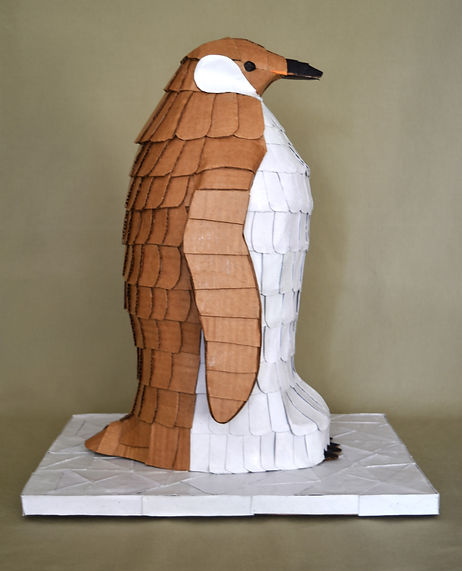CARDBOARD SCULPTURES
The sculptures on this page are upcycled sculptures made of cardboard. They offer a creative alternative to disposing of or recycling cardboard boxes. Upcycled art is becoming more and more popular. I have found it to be very challenging but rewarding!
Dolphin - "Grace"
19.5 in L, 11 in W, 16.5 in H
There are several species of dolphin that occur in Florida coastal and estuarine waters. The most common is the bottle-nosed dolphin. They average 8 - 10 feet in length and 300-650 pounds. They are extremely intelligent and communicate through sounds and ultrasonic pulses. The bottle-nose dolphin is not threatened or endangered but are protected under the Marine Mammal Protection Act. They are very social animals that may travel alone or in groups. They feed on a variety of prey such as fish, squid and crustaceans. They usually live at least 40 years with females living longer than males up to 60 years. Dolphins are susceptible to a number of human-caused and natural threats and stressors.


Hippopotamus - "Kiboko"
23.5 in L, 16 in W, 17 in H
#1 sold, #2 available
Hippopotamus is derived from the Greek for river horse. They can be found in the waters of rivers, lakes and swamps next to grasslands. They are found in eastern, central and parts of southern Africa. Because of their large size they are safe from most predators except for man. They are hunted for their hide, meat and ivory, and often killed for raiding crops. They are well adapted for their semi-aquatic existence. The ears and nostrils can be folded shut to keep water out. Their bodies are very dense which allows them to walk under water and they can hold their breath for up to 5 minutes. They have skin glands which secrete a reddish oily substance which acts as a sun block. They graze primarily on grass next to rivers and waterways. They can be very aggressive and the yawning display is often used in territorial displays. The translation of hippo into Swahili is "Kiboko".


Black Rhino - "Horns"
23 in L, 7 in W, 13 in H
The black rhino is native to eastern and southern Africa. Overall, the species is classified as critically endangered. They are primarily browsers feeding on leaves of shrubs and trees. They are threatened primarily by poaching for the illegal international market for their horns. The horn has been used in traditional medicine and is a status symbol of success and wealth. The current population is estimated at about 6000. Unfortunately poaching is on the rise again. There are numerous conservation programs to help save the black rhino. You can help by supporting these organizations with a donation.


Emperor Penguin - "Broody"
13.5 in L, 10.5 in W, 17 in H
The emperor penguin is the largest of all living penguin species. It can stand up to 44 inches and weigh 60 to 90 lbs. They live on the Antarctic continent and can live 20 to 25 years. They are listed as near threatened by the IUCN. They breed during the Antarctic winter and do not build nests. The male stands upright and incubates a single egg on top of its feet under a fold of skin called a brood patch. The Antarctic Treaty of 1959 makes it illegal to harm, or in any way interfere with an emperor penguin or its eggs.


Manatee - "Tranquility"
22 in L, 11 in W, 7.5 in H
The Florida manatee is a subspecies of the West Indian manatee. They feed on seagrass, algae and other vegetation in freshwater and estuarine systems in the southeastern United States. They require warm water environments to survive. They are listed as threatened by the U.S. Fish and Wildlife. Due to their high buoyancy and slow speed, they are often struck by vessels. There are also die-offs due to red tide and cold weather events.


Mountain Gorilla - "Sacamunto"
19 in H, 18 in W, 12 in D
The Batwa pygmies lived alongside the mountain gorillas in the Bwindi Impenetrable Forest. The Batwa did not hunt the mountain gorillas and their name for them was Sacamunto - 'Just like me".


Giraffe - "Kameelperd"
31 in L, 11.5 in W, 22 in H
Kameelperd is the Afrikaans word for giraffe. Loosely interpreted it means camel/leopard.


Cape Buffalo - "Dagga Boy"
23 in L, 36 in W, 22 in H
Dagga Boy is used to describe an old, usually solitary cape buffalo bull. They have usually been forced out of the herd by younger virile bulls. Dagga refers to the thick black clay that covers their skin. Dagga being another word for mud.


